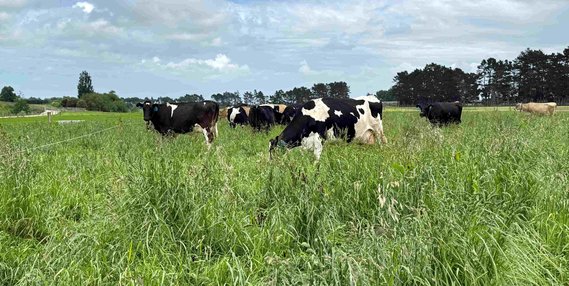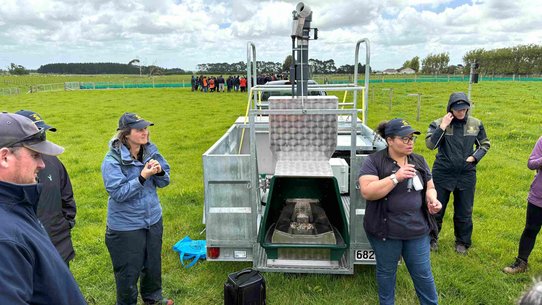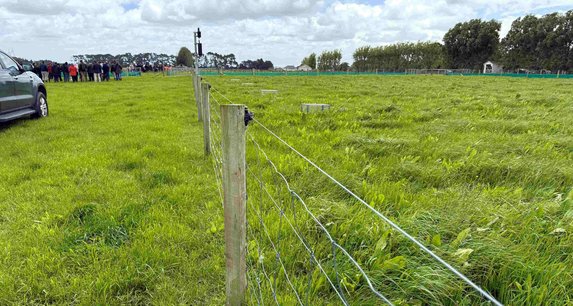What might the future hold?
“If you always do what you’ve always done, you’ll always get what you’ve always got.”
Henry Ford wasn’t talking about farming, but he might as well have been.
That’s why we are closely following what is probably the most extensive research into pasture management in New Zealand since Mac McMeekan’s work in the 1950’s. And so should you!
Maybe the results will challenge decades of conventional wisdom about pastures and pasture management. Maybe they won’t. Either way, we’re keeping an open mind.
Early days
Barenbrug is a partner in Whenua Haumanu, a seven year, $26 million science project investigating a number of aspects of regenerative agriculture under animal grazing.

On the dairy farm very long pasture under the regen grazing management - do we need to get used to seeing this?
Like everyone else involved, we’re keen to learn exactly what happens – to soil health and biology, water, emissions, plants, animals and end products – when cows, sheep and beef cattle are farmed regeneratively, vs conventionally.
This is an ambitious, complex undertaking. As such, even though it began over two years ago, it’s barely out of the starting blocks.
Dedicated research farms have had to be set up at Massey and Lincoln Universities; conventional and diverse pastures established and stocked; management systems implemented and refined; baseline data collected.
Scale and scope
Whenua Haumanu is the biggest pastoral and grazing project backed in recent years by the Ministry for Primary Industries through Sustainable Food and Fibre Futures.
At $17.5 million it also has received the most taxpayer funding, and, with 17 partners, features the widest industry representation.
Leaving aside a range of regional satellite projects, core research centres on three separate livestock systems – dairy, and summer-safe sheep/beef in Manawatu; dryland sheep in Canterbury.
Each compares basically four main farm systems: Animals grazing conventional best practice pastures against regen management, both of those grazing conventional and diverse pastures. Researchers are assessing any differences in a dizzying array of physical, environmental and performance metrics, and also reasons for these differences.
Trove of data
Implications of this work could be far-reaching.
And since the future of farming is also our future, we want to stay abreast of any potential developments or trends that emerge.
Regardless of outcomes, Whenua Haumanu will gather a trove of data to inform us all about both existing pasture practices, and alternatives that might be useful in future.

Detailed assessments of soil biodiversity include counting these five species of earthworms.
Dozens of scientists, technicians, farm staff and post-graduate students across multiple disciplines, from entomology to animal science, are involved.
They’re gathering so much information, including assessments of meat and milk produced by trial animals, that Whenua Haumanu has generated its own data capture and analysis system.
Taking risks
Project leader Professor Danny Donaghy, Massey University, says a key priority this coming year is applying more pressure to the dairy and sheep/beef research farmlets in Manawatu.
“We’ve eased our way into them so far; we needed to find out how much the different pastures would produce, and what stocking rates were appropriate.
“But I think it is the role of a research facility to take risks.
“So we’re going to start stressing the systems now, in terms of things like grazing frequency and fertiliser. You’re not going to get system failure if you play it safe!”
Pasture plants themselves will also be scrutinised more intensely, not least to discover why some survive better in diverse swards than others.
Functional diversity
A surprise early result is that diverse pastures have emitted 60% less nitrous oxide than conventional, regardless of grazing management. Assessments are on-going to check this is a consistent effect.
Meantime, Danny encourages farmers interested in diversifying pastures, by putting extra species in a seed mix, to be very clear about their objectives, rather than doing so for the sake of it.
“What is it that you’re hoping to achieve? Is it summer activity, or late winter growth into spring? Do you want to improve soil quality?
“Or do you want better feed yield and quality, improved animal performance, less requirement for nitrogen fertiliser, or pasture better able to survive summer drought?”
Focusing first on desired outcomes is the best way to capture potential benefits from functional pasture diversity, he says.
The ultimate measure
Ewe and lamb productivity has been an early focus at the Whenua Haumanu farmlet at Lincoln University.
Here, existing best practice dryland pastures and management are being compared with diverse pastures and regenerative management, under high and low soil phosphorus levels.

Methane trailer - sheep are trained to eat a small amount of offered feed during which their methane output is captured.
“The ultimate measure of any of these systems is liveweight gain per hectare,” says Dr Alistair Black, who runs the Lincoln project. “So we’ve started at the animal productivity level as we’ve been getting the farmlets set up and running properly.”
Myriad other physical characteristics are also being recorded.
But most involve organic processes that take time to show change compared to separate mobs of ewes grazing different treatments year round, either with their lambs or replacement hoggets.
Test the limits
As well as providing hard data on diverse dryland pastures farmed regeneratively, this trial is an ideal way to test the limits of conventional dryland systems using lucerne, sub-clover and cocksfoot.

A sheep farm pasture under conventional management (L) is shorter than a diverse pasture under regen management.
Cages are to assess growth and botanical composition.
“We really wanted to challenge a legume based system, year round, over the long term,” Alistair says.
On top of on-going routine measurements, other areas of comparison between the different systems currently include resource use efficiency; trends in botanical composition over time; and animal nutrition, intake and digestibility.
We encourage you to stay tuned for findings that may benefit your farm system. And remember we are always here to help with any questions you may have around any of your pastures, diverse or otherwise. Book your free Pasture Health Check today.


